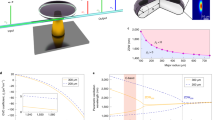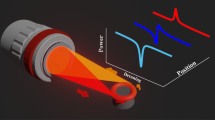Abstract
Because of their small mode volume and high Q-factors, optical microresonators are interesting for applications such as laser sources, active filters and all-optical switches. Especially interesting are tunable resonators, in which the resonance frequency tuning by size, shape, temperature or electric field can be achieved. Here we demonstrate electrically tunable, low-loss whispering-gallery-mode (WGM) resonators made of nematic liquid crystal droplets, embedded in a polymer matrix. The shift in resonant frequencies is achieved via electric field-induced structural distortion of the birefringent liquid crystal resonator medium. Nematic liquid crystal microresonators have a large tuning range of the order of 20 nm at 2.6 V µm−1 for a ∼600 nm WGM in 17-µm-diameter droplets and high Q-factors up to ∼12,000 in 33-µm-diameter droplets. The tunability is approximately two orders of magnitude larger than usually achieved in solid-state microresonators.
This is a preview of subscription content, access via your institution
Access options
Subscribe to this journal
Receive 12 print issues and online access
$209.00 per year
only $17.42 per issue
Buy this article
- Purchase on Springer Link
- Instant access to full article PDF
Prices may be subject to local taxes which are calculated during checkout






Similar content being viewed by others
References
Ashkin, A. & Dziedzic, J. M. Observation of resonances in the radiation pressure on dielectric spheres. Phys. Rev. Lett. 38, 1351–1354 (1977).
Vahala, K. J. Optical microcavities. Nature 424, 839–846 (2003).
Kiraz, A., Kurt, A. & Dundar, M. A. Simple largely tunable optical microcavity. Appl. Phys. Lett. 89, 081118 (2006).
Saito, M., Shimatani, H. & Naruhashi, H. Tunable whispering gallery mode emission from a microdroplet in elastomer. Opt. Express 16, 11915–11919 (2008).
Maune, B., Lawson, R., Gunn, C., Scherer, A. & Dalton, L. Electrically tunable ring resonators incorporating nematic liquid crystals as cladding layers. Appl. Phys. Lett. 83, 4689–4691 (2003).
Piegdon, K. A., Matthias, H., Meier, C. & Kitzerow, H.-S. Tunable optical properties of photonic crystals and semiconductor microdisks using liquid crystals. Proc. SPIE Int. Soc. Opt. Eng. 6911, 6911OJ (2008).
Wang, T.-J., Chu, C.-H. & Lin, C.-Y. Electro-optically tunable microring resonators on lithium niobate. Opt. Lett. 32, 2777–2779 (2007).
Kiraz, A., Karadag, Y. & Coskun, A. F. Spectral tuning of liquid microdroplets standing on superhydrophobic surface using electrowetting. Appl. Phys. Lett. 92, 191104 (2008).
de Gennes, P. G. & Prost, J. The Physics of Liquid Crystals 2nd ed. (Oxford Science, 1993).
Song, M. H. et al. Electrotunable non-reciprocal laser emission from a liquid-crystal photonic device. Adv. Funct. Mater. 16, 1793–1798 (2006).
Hands, P. J. W. et al. Two-dimensional liquid crystal laser array. Opt. Lett. 33, 515–517 (2008).
Munoz, A. F., Palffy-Muhoray, P. & Taheri, N. Ultraviolet lasing in cholesteric liquid crystals. Opt. Lett. 26, 804–806 (2001).
Moreira, M. F. et al. Cholesteric liquid-crystal laser as an optic fiber-based temperature sensor. Appl. Phys. Lett. 85, 2691–2693 (2004).
Cao, W., Munoz, A., Palffy-Muhoray, P. & Taheri, B. Lasing in a three-dimensional photonic crystal of the liquid crystal blue phase II. Nature Mater. 1, 111–113 (2002).
Morris, S. M., Ford, A. D., Pivnenko, M. N. & Coles, H. J. Enhanced emission from liquid crystal lasers. J. Appl. Phys. 97, 023103 (2005).
Humar, M. et al. Electrically tunable diffraction of light from 2D nematic colloidal crystals. Eur. Phys. J. E 27, 73–79 (2008).
Doane, J. W., Vaz, N. A., Wu, B.-G. & Žumer, S. Field controlled light scattering from nematic microdroplets. Appl. Phys. Lett. 48, 269–271 (1986).
Bodnar, V. G., Lavrentovich, O. D. & Pergamenshchik, V. M. Threshold of structural hedgehog-ring transition in drops of a nematic in an alternating electric field. Sov. Phys. JETP 74, 60–67 (1992).
Stark, H. Physics of colloidal dispersions in nematic liquid crystals. Phys. Rep. 351, 387–474 (2001).
Novotny, L. & Hesht, B. Principles of Nano-Optics (Cambridge University Press, 2006).
Cohoon, D. K. An exact solution of Mie type for scattering by a multilayer anisotropic sphere. J. Electromagnet. Wave. 3, 421–448 (1989).
Gu, Y., Abbott, N. L. Observation of Saturn-ring defects around solid microspheres in nematic liquid crystals. Phys. Rev. Lett. 85, 4719–4722 (2000).
Eversole, J. D., Lin, H-B. & Campillo, A. J. Input/output resonance correlation in laser-induced emission from microdroplets. J. Opt. Soc. Am. B 12, 287–296 (1995).
Acknowledgements
The authors would like to thank P. Ropret, S. Žumer, M. Škarabot, S. Pečar, J. Pirš and J. Štrancar for their help and suggestions. This work was supported by the Slovenian Research Agency under the contracts P1-0099 and J1-9728.
Author information
Authors and Affiliations
Contributions
M.H. performed all experiments and analysed the results. M.R. has carried out the theoretical calculations. S.P. synthesized the SPP-106 dye. I.M. initiated the work on WGM resonances in LC droplets, organized and supervised the experiments. M.H., M.R. and I.M. wrote the manuscript.
Corresponding author
Supplementary information
Rights and permissions
About this article
Cite this article
Humar, M., Ravnik, M., Pajk, S. et al. Electrically tunable liquid crystal optical microresonators. Nature Photon 3, 595–600 (2009). https://doi.org/10.1038/nphoton.2009.170
Received:
Accepted:
Published:
Issue Date:
DOI: https://doi.org/10.1038/nphoton.2009.170
This article is cited by
-
Liquid crystal-amplified optofluidic biosensor for ultra-highly sensitive and stable protein assay
PhotoniX (2021)
-
Continuous-wave upconversion lasing with a sub-10 W cm−2 threshold enabled by atomic disorder in the host matrix
Nature Communications (2021)
-
Photothermal control of whispering gallery mode lasing in polymer-coated silica microcavity using high-efficiency nanoheater
Journal of Materials Science (2021)
-
Optothermal dynamics in whispering-gallery microresonators
Light: Science & Applications (2020)
-
3D-printed optical-electronic integrated devices
Science China Chemistry (2019)



